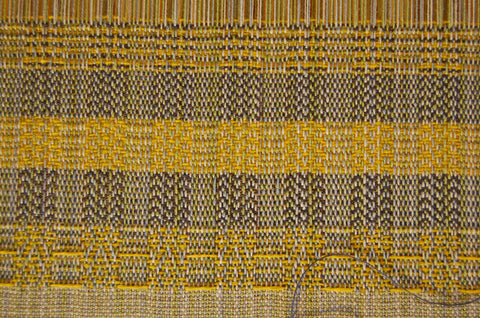By Melissa Ludden Hankens
When I started planning this project, I thought it was going to be about overshot, but a few things happened along the way. The first was that I decided overshot needed a bit more time and research before I can provide you with a clear and user-friendly article. So I promise you overshot in the future, just not this month.
The second thing to happen was Margo Selby. If you haven't seen her book, Color and Texture in Weaving, I would strongly suggest tracking down a copy. Many libraries have weaving books on their shelves. This is a great way to experience what a given book has to offer without plunking down the cash until you are sure you can't live without it (the cash and the book). Her work inspired me to experiment, changing colors and textures on the fly until I was satisfied with the outcome.
My original plan was to weave a cotton and wool fabric for a simple jacket for fall. I selected 8/2 unmercerized cotton for the warp. Always a fan of being more efficient, I wound my five-yard warp three ends at a time (I was blending three colors). Then I threaded the full 26" width of my Baby Wolf at 24 ends per inch. Unmercerized cotton is not as slippery as its mercerized sister.
Be sure that you only comb your warp clear from the beater to the breast beam while winding on your warp. This is especially helpful when your warp ends are not quite as cooperative as you anticipated and you are dealing with a fairly long warp. I will also point out that I am a front to back warper. I will leave it at that as conversations about warping techniques tend to get a bit heated, don't you think?
We managed to make it through, me and my warp, but I did end up with three broken threads in the process. I suspect this may have something to do with winding multiple ends at a time when measuring out the warp.
Note: I just finished warping my Baby Wolf with the same 8/2 cotton, winding one end at a time on my warping board, and beaming on the warp was a cinch! No tangles or broken ends.
I chose Harrisville Shetland wool for my pattern weft and the 8/2 cotton for my tabby weft. This babble will make more sense when the overshot article comes to town. I wove for about an inch and quickly decided that there wasn't enough contrast between the yarn colors for the pattern to stand out. I was happy with my yarn choice and already on the fence about my article topic, so rather than choose a new pattern yarn, I opted to toss the overshot article out the window, and I started fussing about with the draft.
Note: The original pattern I selected was from Marguerite Porter Davison's book A Handweaver's Pattern Book, p. 134 Squares with Diamonds III. My final fabric used the same threading sequence, but my tie up changed to 1-2(A), 2-3(B), 3-4(C), 1-4(D) and I treadled A-B-C-D-C-B, repeat.
Let the sampling begin! First I wove an inch of the original pattern using only 8/2 cotton. I skipped the tabby shots altogether, making only the pattern picks. I really liked how this looked, as the color I used was a darker blue that was nicely complemented by the pale blue and green yarns of my warp, but I wanted a fabric with more body. Next I wove an inch of pattern picks using the Shetland. The yellow didn't stand out as well, but gave the fabric a nicer feel.

samples
I wasn't totally sold on either of these efforts and certainly wasn't excited about the prospect of rethreading my heddles, but could easily make changes to both my tie-up and my treadling sequence. As I adjusted these two variables, I wove approximately an inch for each change making a note of my new draft each time. After my fifth attempt, I had my voilà moment. I found a treadling and tie-up sequence that just struck me as right. My apologies if this draft exists already. I came by it honestly!
There is something so pleasing about making cloth that you love. I think Margo Selby puts it best in her book when she says, "The enjoyment of weaving comes as much from the creative process as it does from the practical satisfaction of building your own cloth from scratch."
Interestingly, the section of cloth comprised of one-inch samples of the various treadling and tie-up changes I made is my favorite part of the cloth. I am not someone who is inclined to weave in color. In my personal weaving, I tend to use natural fibers and colors, so this little experiment opened a new door for me.

final fabric
My 5-yard warp yielded 125" of fabric, post-wash. You can use a shorter warp. When my finished fabric didn't cry out jacket, I used half of it to make a simple tote for my mother. The other half was transformed into a bench cushion cover, highlighting the sampled area. This month, I will give you basic instructions for how to make a bench cushion and cover. If you are new to sewing, this only involves stitching in a straight line a few times. You can do this by machine or by hand – I used a combination of both.

Don't be afraid to experiment and change your mind as you weave. By embracing a more flexible approach to your weaving, you may just end up with something amazing.

